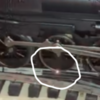This is a Lionel 2231670 consolidation, and it is not cooperating (or the switch isn't) to track down the source of a brief short. If the loco runs through the switch over a certain speed, as you will see in the video, the short occurs but is not long enough to blow a fuse. If I run it slowly, it blows the fuse at a particular spot on the switch.
If it goes through the switch in reverse, no problem, if it goes into the turn track- no problem. None of my other locomotives have had an issue like this on this switch.
My operative theory is that some strange combination of the pickup rollers, their position, and the switch components is causing a short to ground at the point of the spark you see, where the third wheel (which is a dummy wheel) meets one part of the switch outside rail. I have put short pieces of electrical tape to cover various parts of the switch- no luck, measured voltage and ohm measurements between the switch pieces and no luck finding anything obvious. If it was something like a pinched wire inside the locomotive, it seems I would get the short someplace else on the layout too, but I don't. Even more confusing, it appears the spark only occurs on the right side of the locomotive but not 100% sure of that.
Why that wheel would suddenly become momentarily "hot" is a mystery. Grasping for ideas here! Thoughts welcome.
Here is a picture of the short occurring and the video is below that - the short occurs at about 6 seconds.














